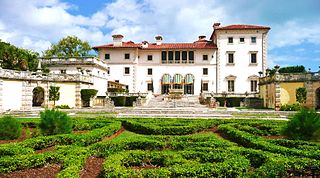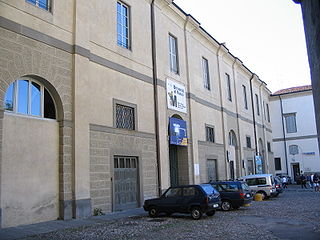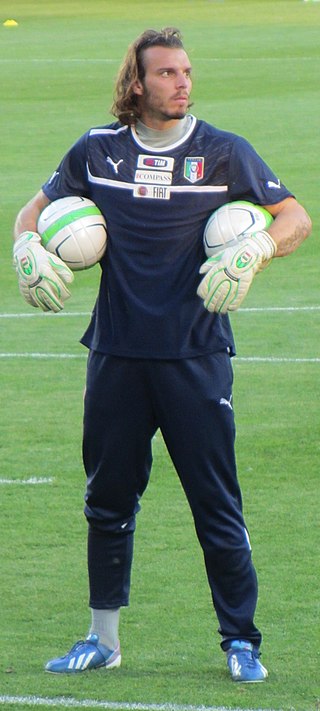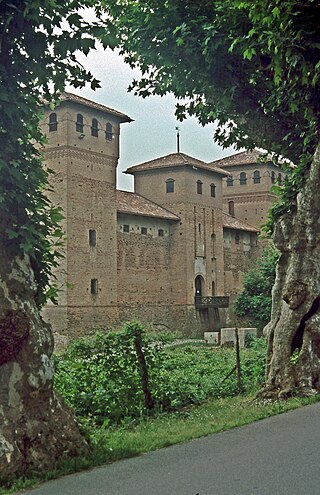
Cisterna di Latina is a town and comune in the province of Latina in Lazio, of central Italy. It was the scene of the Battle of Cisterna in January 1944.

The Vatican Museums are the public museums of the Vatican City. They display works from the immense collection amassed by the Catholic Church and the papacy throughout the centuries, including several of the most well-known Roman sculptures and most important masterpieces of Renaissance art in the world. The museums contain roughly 70,000 works, of which 20,000 are on display, and currently employ 640 people who work in 40 different administrative, scholarly, and restoration departments.

The Villa Farnese, also known as Villa Caprarola, is a pentagonal mansion in the town of Caprarola in the province of Viterbo, Northern Lazio, Italy, approximately 50 kilometres (31 mi) north-west of Rome. This villa should not be confused with the Palazzo Farnese and the Villa Farnesina, both in Rome. A property of the Republic of Italy, Villa Farnese is run by the Polo Museale del Lazio.

Bracciano is a small town in the Italian region of Lazio, 30 kilometres northwest of Rome. The town is famous for its volcanic lake and for a particularly well-preserved medieval castle Castello Orsini-Odescalchi. The lake is widely used for sailing and is popular with tourists; the castle has hosted a number of events, especially weddings of actors and singers.

The Vizcaya Museum and Gardens, previously known as Villa Vizcaya, is the former villa and estate of businessman James Deering, of the Deering McCormick-International Harvester fortune, on Biscayne Bay in the present-day Coconut Grove neighborhood of Miami, Florida. The early 20th-century Vizcaya estate also includes extensive Italian Renaissance gardens, native woodland landscape, and a historic village outbuildings compound.

Ladispoli is a town and comune in the Metropolitan City of Rome, Lazio, central Italy. It lies about 35 kilometres (22 mi) west of Rome, on the Mediterranean Sea.

Cosimo Fanzago was an Italian architect and sculptor, generally considered the greatest such artist of the Baroque period in Naples, Italy.

Civic Museum of Natural Science Enrico Caffi is a natural history museum in Bergamo, Italy. The museum has more than 55,000 artifacts, fossils, animal and plant specimens. The museum is founded in 1918 and, after multiple moves, is currently located at Piazza Cittadella. The museum also hosts a library and provide education activities for schools in the region.

Federico Marchetti is an Italian professional footballer who plays as a goalkeeper for Serie A club Spezia.
DonCarlo Caracciolo, 9th Prince of Castagneto, 4th Duke of Melito, was an Italian publisher. He created Gruppo Editoriale L'Espresso, one of Italy's leading publishing groups, which included Italy's newspaper of record, La Repubblica. He was known as "the editor prince", a reference to his aristocratic birth and elegant manner.

The Papal Palace of Castel Gandolfo, or the Apostolic Palace of Castel Gandolfo from its Italian name Palazzo Apostolico di Castel Gandolfo, is a 135-acre (54.6-ha) complex of buildings in a garden setting in the city of Castel Gandolfo, Italy, including the principal 17th-century villa, an observatory and a farmhouse with 75 acres (30.4 ha) of farmland. The main structure, the Papal Palace, has been a museum since October 2016. It served for centuries as a summer residence and vacation retreat for the pope, the leader of the Catholic Church, and is afforded extraterritorial status as one of the properties of the Holy See. It overlooks Lake Albano.
Dan Pearson is an English landscape designer, specialising in naturalistic perennial planting.

Stormfield was the mansion built in Redding, Connecticut for author Samuel Clemens, best known as Mark Twain, who lived there from 1908 until his death in 1910. He derived the property's name from the short story "Captain Stormfield's Visit to Heaven". The building was destroyed in a 1923 fire, with a smaller replica built at the same site the following year.

Visconti Park was the private park of the Visconti and Sforza families, lords, and dukes of Milan. Located in Lombardy, northern Italy, it extended between the Pavia Castle and the Pavia Charterhouse. It covered an area of about 2,200 hectares (22 km2) and was encircled by walls about 25 kilometres (16 mi) in length. It was founded in 1360 by Galeazzo II Visconti and enlarged by his son Gian Galeazzo. Its decay began in 1525 with the damages inflicted during the Battle of Pavia. Today, the park's area mainly serves agriculture purposes, while some portions are nature reserves.

Villa Albergoni is a villa in Moscazzano, Cremona, Lombardy, northern Italy that dates back to the 16th-century. Due to previous owners, it is also known as Palazzo or Villa Vimercati, Villa Griffoni or Villa Sant'Angelo. It is located at 3, Via Montodine.

The beach of Capocotta is the area of the Roman coast between Castel Porziano and Torvaianica, one of the best preserved stretches of dunes in Italy.
With an extension of 45 hectares, since 1996 it is part of the Litorale Romano State Nature Reserve.

The Visconti Castle of Cherasco is a medieval castle in Cherasco, Piedmont, Northern Italy. It was built in the 14th century by Luchino Visconti, Lord of Milan, and partly reconstructed at the beginning of the 20th century.

The ancient Roman villa of Quintus Axius was a large rural villa rustica in the locality of Grotte di San Nicola, Colli sul Velino, Italy.

















